A Morning with the Master: On Deck with Coach Bill Sweetenham
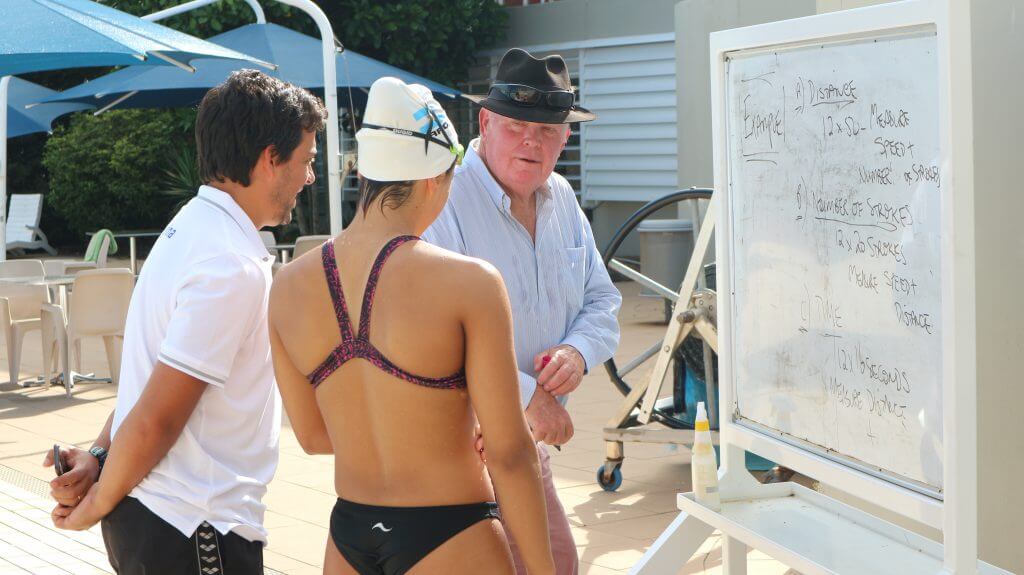
A Morning with the Master: On Deck with Coach Bill Sweetenham
By Wayne Goldsmith
I’ve known Coach Bill Sweetenham for a long time. He’s been one of the strongest and most positive influences on my life and he continues to be a respected colleague, a trusted mentor and a great personal friend.
Everywhere I go, I meet people who’ve worked with Bill, listened to him present at a Conference, read about him in the media or studied his work in a swimming magazine.
I also run into a lot of Bill’s ex-swimmers, former coaching colleagues, former staff and people who’ve known him in various capacities throughout his astounding career in the sport.
Everyone it seems – has a “Bill” story.
Everyone’s got a tale, a funny story, an anecdote, a piece of Sweetenham philosophy or a joke to tell about their experiences with Bill in the past.
This article is about Bill now and about my experience being with him on deck recently on the Gold Coast.
This “Bill” story – is the best one you’ve ever heard.
Meet Coach Bill Sweetenham in person when he is inducted into the International Swimming Hall of Fame
Coach Bill Sweetenham…Looking Back.
There’s a saying:
If people from my past talk about me now, they are talking about a person they no longer know.
This saying – when applied to Coach Bill Sweetenham – is entirely accurate and very true.
When I mention Bill’s name around the world, swimmers and coaches who’ve worked with him in the past will often give me a wry smile and use words like “tough” or “hard” or “uncompromising” or “relentless” to describe him.
And that’s true. He is all those things. He is tough. He’s hard. He’s definitely uncompromising and he’s certainly relentless.
He’s occasionally joked with me that when he moves on from this world, he’d like the following words on his grave-stone:
BILL SWEETENHAM – NO COMPROMISES
There’s no doubt that over a 40 year career in swimming Bill has developed a reputation for hard work, for discipline and for the relentless pursuit of excellence at all levels of the sport.
My wife Helen Morris was an elite swimmer who’d been selected in a few teams in which Bill was head coach. A dual Commonwealth Games medalist in fly and breast, a former USA National Open champion, a Pan Pac medalist, a psychologist, a school teacher, a black belt in Hapkido and a mother of four – she’s a confident woman who’s afraid of nothing and no-one. In 20 years of marriage the only time I’ve ever seen fear in her eyes was a few years go when Bill expressed a concern he had simply by saying the word “Helen” in a typical intense “Bill” way – and she shuddered and replied “Yes coach” as if she’d just met Darth Vader in a dark room.
Bill’s reputation for possessing an uncompromising commitment to achievement is well deserved: there is no one in the sport who’s worked harder, given more and who expects higher standards than Sweetenham.
I asked him once why he was so “hard”.
In response, he told me a story about a young swimmer he had coached for whom he had great affection and a close connection with both the swimmer and her family.
The swimmer had worked hard and made the Australian Olympic team. Bill was both her home coach and the national head coach on that team.
She was in a final at the Olympic Games and with ten meters to swim she was in the lead with a gold medal in her keeping.
With a few strokes to go, the swimmer, under great physical pain and emotional pressure, made a few technical errors with her skill execution and as a result she didn’t win a medal.
Bill felt every error as if they were punches rained down on his own head.
As Sweetenham told me, “There is nothing like the pain of seeing a young person who’s dreamed of achieving something – someone who’s spent every waking moment working towards their goal – someone you really care about – having the realization of that dream within their grasp – then having it taken away because of your failure – because of your compromises as a coach. Every time you compromise in coaching it bites you in the backside”.
Bill decided at that moment to never compromise on the standards he would expect from athletes – and coaches – in training.
So why is he perceived as being so “hard”?
To win gold medals? Not really – that’s a consequence of living a lifestyle built on unrelenting standards.
To break world records? No. They come to the athletes who refuse to compromise in their planning, preparation and performance.
The reason Bill is seen as “hard” is that he cares more about his athletes and their success than anyone I’ve ever met.
There’s a myth about Coach Bill Sweetenham – that he’s too hard, too tough, too relentless.
Most people do not really know him at all.
They think they do: but most people do not really understand him or more importantly have no idea why he is who he is.
There’s a difference between HARD and what I call BAST-HARD.
He’s hard – there’s no doubt about it. But he’s not a BAST-HARD. Never has been. It’s not his nature.
He’s hard because he cares deeply about his athletes and it’s because of this that he is not prepared to allow them to fail.
He’s tough because he refuses to see the athletes he cares about not realize their potential.
He’s uncompromising because – as Bill says often – “compromise is the cancer of achievement” – and he cannot accept compromise of any kind in the training environment for the simple reason that he knows – more than anyone – how compromise at training leads to failure and disappointment in competition.
So, now that you know about Bill’s past and his reputation, let’s look at Bill now.
One of the most common questions I get asked about Bill is “would he succeed as an on-deck coach now?” – i.e. would his philosophies about compromise and commitment and hard work be as effective with this generation of athletes?
You be the judge.
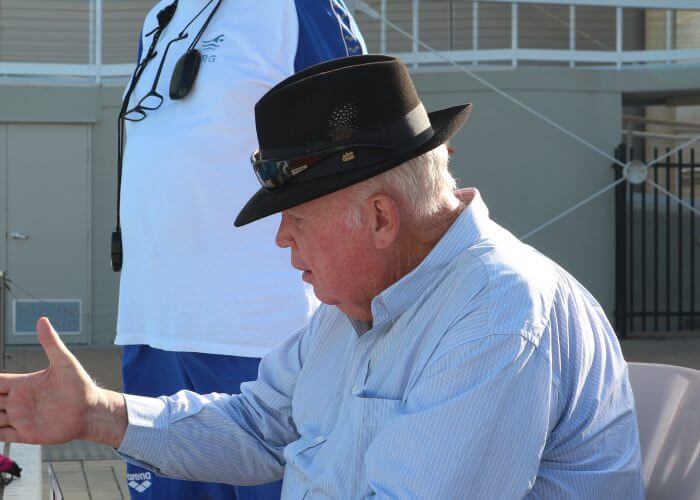
Photo Courtesy: Wayne Goldsmith
Coach Bill Sweetenham…Looking Forward.
Recently Coach Bill Sweetenham invited me to spend some time with him while he coached on deck with a national team. This is what I experienced.
Bill arrived early – as has been his practice since I’ve known him. An avid reader and follower of Asian philosophy, he will regularly quote Sun Tzu – “Always be first onto the field of battle” meaning – arrive early, plan intently, be ready to coach at your absolute best every day – well before the swimmers start to arrive. This extra time gives you the opportunity to prepare more effectively, to apply greater attention to detail and to think about how you can make a difference to every swimmer in the program.
When the swimmers arrive, Bill ushers them to sit around a large table and asks them about how they feel.
Two of the swimmer’s respond, “A little flat”.
Bill asks, “What do you feel you can do to turn that around and get yourselves ready to train well?”
Both swimmers respond, “What about that “nervous system stimulation” routine we learnt last week. Can we head to the gym and do that before warm-up?”
“Great idea”, replied Bill.
He then says, “Guys. I sent you today’s workout last night. (See Below for workout details). Can you tell me what the purpose of today’s session is and how it links with what we did in training yesterday?”
The swimmers gave a range of responses based on their experience, confidence and level of understanding but Bill listened to all of them, asked them questions to clarify their expectations of the workout and gave each swimmer the opportunity to ask questions themselves.
He then spoke directly to one swimmer. “What was the main thing we were working on yesterday in training?”
“Body and head position plus catch and pull in backstroke, coach”, the swimmer answered.
“So” said Bill, “When we get to that main set today, how will you keep that focus on body and head position particularly when you get tired? What are you looking for in your catch and pull during the main set?”
“I was thinking I’ll do that drill we’ve been working on immediately before the set and then include a few strokes of the drill during the actual set”, the swimmer offered.
“Good idea”, said Bill.
This exchange of ideas, thinking and suggestions continued for five minutes with Bill alternately questioning and listening, offering guidance and advice where needed, encouraging open discussion and reflection throughout the pre-training briefing.
Then the workout commenced.
Sweetenham regularly stopped swimmers during their workout to teach lessons.
This is important and worth noting for all coaches.
It has been my experience that far too many coaches are “slaves” to physiology and will blinkerdly drive swimmers to complete training sets – almost in “fear” of losing some written-in-stone, theoretical physiological training adaptation if they dare to interrupt the workout.
Great coaches understand physiology, they use the principles of sports science to help achieve specific performance objectives but they never miss an opportunity to coach the athlete.
Bill would often stop an individual swimmer and invite them to join him at the whiteboard – along with their team coach – and take a few moments to educate – both the swimmer and the coach – on the key aspects of the training activity.
Bill explained to the swimmer and the coach how swimming sets progress. It was beautifully simple – and eloquently delivered.
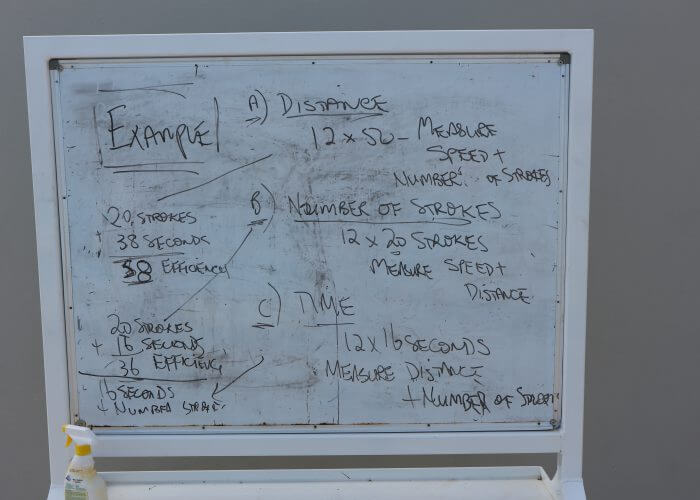
Photo Courtesy: Wayne Goldsmith
He said, “The sport is about three things: speed, stroke efficiency and distance. We aim to get faster, to swim faster with better technique and to maintain speed and great technique over longer – i.e. race distances. So when we design workouts, we create sets and sessions by manipulating, speed, stroke mechanics and distance”.
As Bill was talking to the swimmer and coach, he was writing on the white board – as a teacher would explain a math problem to his students, stopping occasionally to invite comment, to ask a question and to invite discussion. (An image of the whiteboard from the actual session is above).
He then said to the swimmer, “So now you understand what it is we’re trying to do, how can you improve the next section of your workout? Do you change the speed? The stroke count? The distance? Or a combination of them?”
The swimmer thought and replied, “We’ve been working on distance per stroke at race pace, so how about I decrease the rest period (i.e. the interval) and see if I can hold the same stroke count at race pace but with less rest?”
“Great idea”, said Bill.
Over the next two hours the session continued.
There was hard work – a lot of it.
But it hasn’t “hard”, i.e. you didn’t feel like the athletes were being driven or pushed or forced to do it. It felt like they were doing what they wanted to do – that they the athletes themselves were driving the workout.
Sweetenham has battled a medical issue for many years which has been well-documented and discussed openly. He’ll often say that it’s the pain and the challenges of dealing with his injury for more than three decades that have made him even more determined, more focused and more resilient than he ever was. Yet, he’s never used it as an excuse – and I’ve never heard him complain.
But on this morning, he had to sit at the end of the pool from time to time to give his leg a chance to recover from load of walking on deck.
However – even from this position – he still connected with the athletes continually, intelligently and intently.
I’ve seen Bill more physically active on deck – but I’ve never seen him more “active” – i.e. I’ve never witnessed his connection with the athletes and his engagement with the execution of the actual workout so focused and purposeful.
There were a few Bill “classics”…a long “kick for time”, a “kick for distance”, some stroke count at speed and under pressure work – it was all there….but ultimately this was a Master Class in how to coach individual swimmers.
It wasn’t the sets and repeat times that made this session special: it was the way the swimmers chose to do the workout – or rather had been inspired to do the workout – that made it so remarkable.
Perhaps it was the final training activity of the day that most accurately demonstrates Bill’s current coaching philosophies.
The set itself wasn’t all that unique – 12 x 100 on 1:30 (long course meters, push starts). The sort of set completed by swimmers in swimming pools all over the world every day.
The swimmer – a talented young international level athlete – performed the set well – with little or no input from Bill….but he watched – and he saw everything.
63.1
62.7
62.9….
12 x 100 performed to a level you’d expect from a swimmer of that standard.
Then the set was done but you had the feeling that there was about to be more to the story.
I’ve been with Bill when swimmers have got to the same point in their workout on many occasions – and I guessed what was coming next….a classic Sweetenham story about “compromise” or “what it takes to win” war story.
I guessed wrong.
There was a time, in a similar situation where Bill would have insisted on the swimmer doing more, swimming faster, with less rest and continuing until exhaustion – driven primarily by Bill’s own unbreakable will.
This was different.
Instead of “telling and yelling” – Bill “inquired and inspired”.
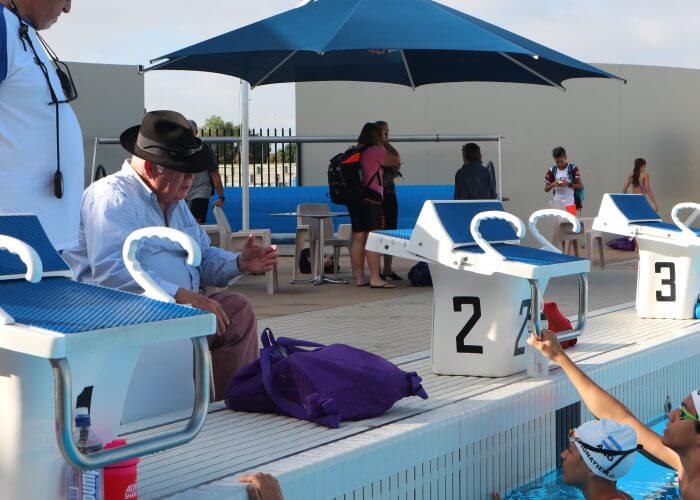
Photo Courtesy: Wayne Goldsmith
“How do you feel?” Bill asked of the swimmer.
“Great thank you, coach. Really good. Just a little tired”, she replied.
“You did a great job. Really good workout” noted Sweetenham.
“Thanks coach” the swimmer said with a beaming smile.
Bill lent forward. “I’ve got a question for you. What is it that you’re trying to achieve?
“I want to be competitive at international level against the best swimmers in the world” the swimmer responded.
“Great goal. Have a think for a moment. Think about the best athletes in your event. Imagine they’re getting out of the pool after a workout this morning and they’ve done a similar session to the one you’ve just completed. How do you think they’d feel?” questioned Bill.
“I am not sure. I guess they’d be totally exhausted. They’d have given everything to their workout” the swimmer replied.
Bill followed on, “And how do you feel?”
Then the “bomb” hit.
Bill asked, “What do you think you can do right now to make this workout extraordinary? Is there anything you can do that would make your training session superior to anything any of your competitors are doing anywhere in the world?”
The swimmer replied, “I think I’ll do another 100. I’ll dive this one and I’ll aim to go under 61 seconds”.
Bill smiled, “Great choice”.
Bill remained seated throughout the entire conversation.
At no time did his voice raise much above a whisper.
He never said “you must” or “you will” or “you have to”.
He just looked into the eyes of the swimmer, talked with the swimmer about what they wanted to achieve and what they believed they needed to do to achieve the success they dreamed of.
In other words, he gave responsibility to – he handed ownership of the workout to – the one person who could actually enhance the success of the session – the swimmer themselves.
The swimmer then willingly, gladly and enthusiastically stood on the blocks, lifted their energy and performance to another level and swam significantly faster than they had during the 12 x 100 set.
At the end of that extra 100, the swimmer looked at Bill.
He said, “Great work. Nice stroke in the back 25. Excellent turn. Strong kick. Very good”.
“I’ve got a question for you”.
And the “dance” continued………Coach and swimmer working together – as a team – as partners in performance – each doing all they can to help the swimmer be all they can be.
Six more times this “swim, question, connect, engage, swim” process was repeated until the swimmer – not the coach – decided that they had given all they had to give – and had performed a workout consistent with their own high ambitions and lofty goals.
I was standing immediately next to Bill throughout this “performance”.
I never heard a negative comment.
He didn’t explain to the swimmer the consequences of NOT demanding more of themselves.
He didn’t even try to impose his considerable presence into the situation.
At no time did he tell “war” stories about other swimmers, other times, other workouts….it was simply a committed coach quietly working with a talented and driven athlete to achieve something remarkable together.
At the end of session, I saw something I thought I’d never see: Bill walking off deck while the athletes were still in the pool. There was a time when he’d stand on deck until the last moment – looking for anything – any minute detail – for any opportunity to help his swimmers improve something.
He gave the swimmers “Personal Skills Time”.
This is a 10-20 minute period where individual swimmers work – by themselves – on the skills they know they need to improve.
This is something we’ve seen in football, rugby, basketball and other team sport codes for some time, where players do “extra” and spend time improving their skills.
Bill commented, “This time is for the swimmers to reflect on their workout and their goals and to think about what it is – in terms of skills like turns, starts, finishes, underwater kick etc. that they need to improve and to spend time working on improving those skills. It’s not about me. It’s about them.”
From my perspective, having spent considerable time with some of the greatest coaches this sport has produced over the past 30 years, having visited over 500 swimming programs all over the world and having also worked directly with coaches in professional football, tennis and a wide range of other sports at the highest level – I can say without hesitation – Coach Bill Sweetenham is better than ever.
More than that – as someone who’s learnt a lot from him – I can’t remember a time when he’s taught me more than he’s teaching me now.
“This” Bill – the 2018 Coach Bill Sweetenham – is a better coach – more insightful teacher – more engaging educator and more effective communicator than he’s ever been.
Coach Eddie Reese has said on more than one occasion that in his view the two smartest people in world swimming are – embarrassingly and very humbling coming from him – Bill and me.
Eddie – as much as I admire, respect and love the guy – is only half right.
I am only smart because I’ve been smart enough to learn from Bill.
His leadership, his mastery of his craft, his wisdom and his perfection of the art of coaching is something few will ever experience – and even fewer would understand even if they did experience it.
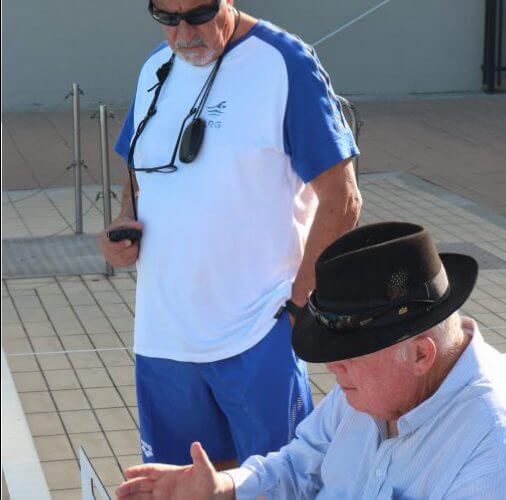
Photo Courtesy: Wayne Goldsmith
So what can you as a swimming coach, take away from this:
- Learning never stops. Getting better never ceases. There is no “end-point” to improvement. There is only a relentless personal commitment to learning, growing and expanding your mind.
- Reputation is only what others think you are. Character – is who you really are. Focus on being the best you can be – and let everyone else think what they like.
- The more you care – the less you’ll be prepared to compromise. Coaching is art of inspiring change through emotional connection. Connect more effectively with your athletes and you – and they – become unstoppable.
- If you’re still trying to get coaching results by telling and yelling – you need to think again. There’s a beauty – a subtlety to coaching that doesn’t need loud voices, whistles or excessive information. Talk less. Listen more. Connect more effectively.
- Being a “hard” coach has nothing to do with imposing your will, forcing kids to do more laps than everyone else, intimating your athletes or having the loudest voice. Being “hard” – is setting a seemingly unattainable standard, one which you know will help your athletes reach and even exceed their dreams and then being reluctant to compromise on that standard at any time: not because you’re a BAST-HARD – but because you care so much about your athletes that you’re not prepared to see them fall short of realizing their potential.
- Work hard. There are no short cuts to excellence. There is no easy road to success. There is no free-ride to gold medals. Work harder more often than anyone else is prepared to.
- Pass on what you learn. There will be other swimming coaches in the future – coaches who want the same things you want – and who want to build sustainably successful programs where swimmers can fulfil their dreams and realize their potential. Your responsibility as a swimming coach now is to ensure the coaches of the future carry with them your legacy of knowledge, experience and learning so that the sport continues to grow, to improve and to flourish for the next 100 years.
- Find yourself a mentor. I’ve been unbelievably lucky that the people I’ve been able to work with have been extraordinary…Bill, Don Talbot, Ralph Richards, David Pyne, Joe King, Ian Pope, Terry Gathercole and many many more outstanding individuals. I got lucky and have had the opportunity to work with some of the great minds and boundless spirits in the sport. Find a few of your own and listen to them.
- Hand over ownership of your workouts to your swimmers. This doesn’t mean the swimmers write the sets and reps and repeat times or design the program. Giving ownership to the athletes means you’ve engaged them in their own training and development process, have educated them to understand HOW and WHY they are doing what they are doing – and then provided them with the opportunity to set and maintain the training standards that will lead them to achieve the success they are seeking. This requires building strong and connected partnerships with the athletes – i.e. it requires outstanding coaching.
- Leave your ego outside please. If Coach Bill Sweetenham – after all he’s done – all he’s achieved – all he’s experienced is still learning, improving and growing as coach – what’s your excuse? I meet young coaches all over the world who think they know it all because they’ve got a University degree in sports science and have coached a kid to a national team. The greatest coaches I’ve met – be they in swimming, in professional football, in tennis, in any of the Olympic sports – the greatest coaches are without doubt the best learners. They have an unquenchable thirst for knowledge, a passion for learning and an insatiable appetite for improvement.
To my friend Bill – thank you.
All I’ve achieved in this sport is due to your inspiration, guidance, teaching, leadership, patience and example.
May you continue to be the benchmark in coaching for a long, long time.
Note: Thanks to Bill for permission to reprint his workouts and for the open and unrestricted access to his training environment.
WG
Bill Sweetenham Workouts – December 8th, 2017.
Swimmer A: Female – international standard distance freestyle.
2 x 150 even paced frs holding 38 seconds per 50 with 28 strokes. On 2-15.
3 x 100 frs holding 1@negative split by 2 seconds, 2@even split, 3 positive split by 2seconds all holding 28 strokes. Pb plus 12 seconds. On 2 minutes
Dive 6 x 50 on 1-15 holding 30 seconds and 26 strokes with 6 breaths.
100 slow motion perfect technique. On 2-30.
Twice through but with 100’s at goal pace 800 with a 1 second differential.
Dive 1 x ? As far as you can Swim holding 28 strokes regardless of time.
Repeat however with this repeat hold strokes as above and then go same distance but hold 1 second faster per 50.
1 x 30 minute kick for distance
1 x 10 minute kick for distance going further than one third of the above distance.
1 x 300 perfect technique minimal effort holding 36 strokes per 50 breathing every 6 strokes.
12 x 100 goal pace for 800 on 1-30 holding minimum strokes even splitting stroke count and time
Personal Skills Time.
Swimmer B: National Level Male Backstroker
Warm up as per Swimmer A but with backstroke focus.
Then:
24 x 50 backstroke lane line drill on every 3rd 50 maximum effort on with as much or as little rest as you need to carry out this drill to PERFECTION. Count strokes on drill. The other 50’s are free holding 31 strokes or better. Simulating your backstroke count.
Kick 40 minutes for distance.
Backstroke with 12 arm strokes per 50 recovery – slow – deliberate. THINK.
Kick 20 minutes for distance as above but going further than half of the above.
300 loosen perfect technique.
Personal Skills Time.
Swimmer C: National Level Female Breaststroker
2 x 150 frs on 2-30
3 x 100’s Dive frs into breaststroke holding PROTOCOLS as previously practised on 2-15
Dive 6 x 50 holding 12 stokes strong kick then swim through on technique on 1-30.
Dive 12 x 12 strokes on odds and x 12 kicks in evens measure the distance. As much or as little rest as you require to carry out this task to PERFECTION.
Push 12 x 20 seconds chasing distance and speed rest as required.
Match all of the above up and compare then explain out come to me.
1 x 20 minute kick / pull for distance alternating 20 second pull then 50 kick. Look for distance.
Personal Skill Time.
Wayne Goldsmith has been an influential figure in world swimming for more than 25 years.
He led Swimming Australia’s National sports science / sports medicine program for many years and has spoken at numerous national and international swimming conferences in the USA, Canada, England, Scotland, Spain, South Africa, South Korea, Japan, The Philippines, New Zealand and Australia.
He has written more than 500 articles on swimming, swimming coaching, swimming science, triathlon and swimming performance which have been published in books, magazines and online all over the world.
Wayne has been a staff writer for Swimming World for the past ten years.
Wayne lives, writes and coaches on the Gold Coast, Australia.





Kirsten Jacobsen
Good read
Great article! Sarah Fredericksen Missy Rose Johnson Hayden Caleb Roach
The best coach!
Swam with Bill in Rocky when I was 15 under Bill Atkinson. Loved reading about Bills ideals and coaching ways.
Hope you are well. This comment takes me back in time to a great period of my life. Thank you for your comment. WIn every day in all that you do. Bill
Nick Lydia Ciffolilli
One of the awesome coach around. Very much appreciated for sharing. 🙂